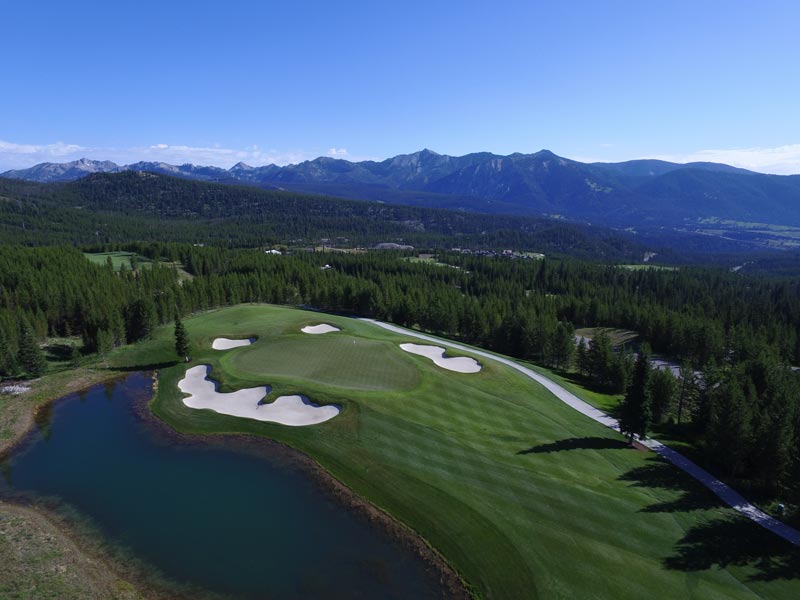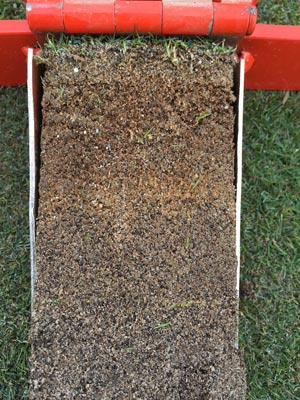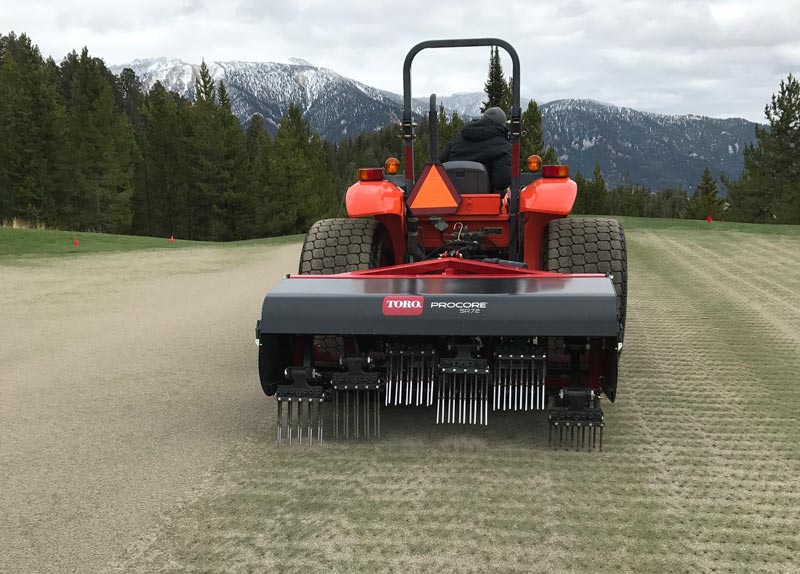
Spanish Peaks Mountain Club in Big Sky, Mont., features an 18-hole Tom Weiskopf design set among pine forests, wildflower meadows and, of course, majestic mountain peaks. Photos courtesy of Ryan Blechta
When I became the golf course superintendent at Spanish Peaks Mountain Club in Big Sky, Mont., in the fall of 2013, I had no idea how much organic content the course’s greens had. When I walked on them, though, it felt like I was walking on my living room carpet.
My initial thought was that this was due to increased thatch levels from being a sodded golf course that had received little maintenance for two years during bankruptcy. I was looking to track how much thatch I had and how much I could remove via different cultivation processes, which led me to David Doherty’s class at the Golf Industry Show, titled “The benefits of oxygen and how to maintain oxygen levels in our root zone.”
I learned about David’s company, International Sports Turf Research Center (ISTRC), and the company’s patented evaluation and reporting method. The ISTRC testing program provides an accurate breakdown of organic material, soil texture and sand size distribution on an inch by inch basis, along with the infiltration rate, water-holding capacity, air and water porosities, percent solids, and bulk density of the soil profile.
Optimizing greens aerification
We had our work cut out for us at Spanish Peaks in the summer of 2014, coming out of bankruptcy and facing high expectations from the new ownership group. Our season here is just four short months — June through September — so any disturbance to the playing surfaces is not ideal. I wanted to make sure we were getting the most out of aerifications so that we could maximize the benefit to the greens — which are Dominant X-Treme creeping bentgrass, a mix of Providence and SR 119 — and so that we would eventually be able to change our process for disrupting the greens.
To better understand the thatch buildup, infiltration rate, air and water porosities, and bulk density of the course, I decided to incorporate the ISTRC testing program for our greens in spring 2015. I intended to use the information to set up a method for tracking the percentage of organic material in the top 2 inches of greens. The testing process is simple: You call ISTRC, they send out their patented coring device and sampling tubes, and you take your samples (ISTRC also has a network of representatives).

Right: A profile of a green at Spanish Peaks, taken midsummer. The tan-colored sand layer is from when the greens were sodded 10 years ago. Also visible is a light-colored vertical sand column, the result of deep aeration. Taking such snapshots reveals how well aeration and topdressing programs are working, and can be helpful in determining how deep to set aerifiers when pulling a core.
The first year of testing, the greens at Spanish Peaks averaged about 7.5 percent organic content in the upper 3 inches of the profile. Additionally, the greens had elevated water porosity, and the bulk density was low. The test results indicated that the greens were in need of an aggressive, proactive culture program to diminish organic material and to control its production in the upper portions of the profiles.
When the quad tine was introduced in the golf industry, it seemed everyone was using it to decrease disruption to the playing surface while still being able to pull a lot out from the cores. I was accustomed to closer hole spacing and two aerifications per year — one in spring before we opened, and one in fall while we were open. I wanted to understand how much displacement the quad tine would give me, and what the best aerification tine would be to remove the most surface organic material.
The tine selection guide from Titan Tines (which is owned by The Toro Co.) calculates displacement based on the numbers you plug in for tine spacing, depth of aeration, and the inside diameter of the tine. Another great reference for selecting the right tine size is the ISTRC aerification displacement chart.
With this information and the test results from ISTRC, I was able to put together a strategy for organic material removal. We switched from aerifying with the standard 3/4-mount, half-inch side-eject tine to using the 3/8-mount half-inch side-eject quad tine, which delivers many more holes per square foot (72 holes vs. 48).
I record in a spreadsheet the information from ISTRC and the displacement numbers, and through this I am able to track organic material percentages in the top 2 inches of the soil profiles. When I receive the next results from ISTRC — we test annually in spring, before we aerate the greens — I can then compare and make adjustments if needed. Thanks to the ability to track our surface area removed per year, we will eventually be able to avoid pulling a core from the greens, instead using solid-tine aeration and filling with sand.
With the change of aerification tines and the addition of a deep verticut during the spring aerification process, I have been able to eliminate the fall core-aerification altogether. Deep verticutting can actually remove more surface organic material than core aeration, and in most cases, the organic material removal is limited to the upper 1 inch of the root zone.
Getting results at Spanish Peaks
The organic-material removal program I’ve initiated at Spanish Peaks helps me monitor the aging process of the greens, evaluate the effectiveness of my current cultural practices, modify the program based on data if need be, make adjustments to the program to meet the individual needs of specific greens, and detect problems before they can affect the health of the greens.

The 16th hole at Spanish Peaks undergoing deep-tine aeration.
Over the past four years, we have documented the obvious correlation between organic material removal and air porosities and infiltration rates. All too often in the maturation of sand-based USGA greens, excessive organic material buildup over time results in imbalances in the pore spaces that can be upward of a 3:1 to 4:1 water-to-air ratio. My ability to move water and air into and through the root zone is extremely important for the greens to work efficiently, which is why I continue to pull a core. Eventually, though, by tracking the organic material in our greens, we’ll just need to punch a hole in greens to get that movement rather than deep verticutting or core-aerating every year.
All of this combined with other practices such as venting via a HydroJect and needle tines, regular topdressing and regular grooming of the turf has proved tremendously beneficial to turf health. Our overall goal has been to increase firmness and consistency by removing excessive amounts of organic material that contribute to water-holding at or near the greens’ surfaces.
We have made a few tweaks to the program since starting in 2015, but we are on track to get organic content in the upper root zone to 3 to 4 percent by 2021 — a huge improvement to Spanish Peaks’ putting greens. And being able to completely do away with fall aerification has significantly decreased the impact our maintenance practices have on our club’s membership.
It’s my opinion that it is not the number of aerifications per year that is important, but rather how much displacement superintendents are able to perform. Aerification needs can vary dramatically from course to course, so while the specifics of what has worked at Spanish Peaks may not work at your facility, having measurable data you can track and use to reach your goal is the key to success — to ultimately providing high-quality greens that your golfers will enjoy.
Editor’s note: This article was adapted from the Spanish Peaks Golf Course Maintenance website.
Ryan Blechta is the golf course superintendent and director of mountain operations at Spanish Peaks Mountain Club in Big Sky, Mont., where he has worked since 2013. A 21-year member of GCSAA, Ryan earned a bachelor’s degree in turfgrass management from the University of Minnesota Crookston. He is currently on the Peaks & Prairies GCSA board of directors.